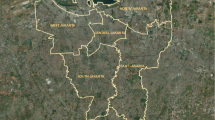Abstract
The daily activity-travel patterns of individuals often include interactions with other household members, which we observe in the form of joint activity participation and shared rides. Explicit representation of joint activity patterns is a widespread deficiency in extant travel forecasting models and remains a relatively under-developed area of travel behavior research. In this paper, we identify several spatially defined tour patterns found in weekday household survey data that describe this form of interpersonal decision-making. Using pairs of household decision makers as our subjects, we develop a structural discrete choice model that predicts the separate, parallel choices of full-day tour patterns by both persons, subject to the higher level constraint imposed by their joint selection of one of several spatial interaction patterns, one of which may be no interaction. We apply this model to the household survey data, drawing inferences from the household and person attributes that prove to be significant predictors of pattern choices, such as commitment to work schedules, auto availability, commuting distance and the presence of children in the household. Parameterization of an importance function in the models shows that in making joint activity-travel decisions significantly greater emphasis is placed on the individual utilities of workers relative to non-workers and on the utilities of women in households with very young children. The model and methods are prototypes for tour-based travel forecasting systems that seek to represent the complex interaction between household members in an integrated model structure.
Similar content being viewed by others
References
Chandraskharan B & Goulias KG (1999) Exploratory longitudinal analysis of solo and joint trip making in the puget sound transportation panel. Transportation Research Record 1676: 77–85
Fujii S, Kitamura R & Kishizawa K (1999) An analysis of individuals’ joint activity engagement using a model system of activity-travel behavior and time use. Transportation Research Record 1676: 11–19
Gliebe JP (2004) Models of household joint decision making in activities and travel. Ph.D. Dissertation, Northwestern University, Evanston, Ill
Gliebe JP & Koppelman FS (2000) A model of joint activity participation. Paper presented at the 9th International Association of Travel Behaviour Research, Gold Coast, Queensland, Australia
Gliebe JP & Koppelman FS (2002) A model of joint activity participation between household members. Transportation 29: 49–72
Golob T & McNally M (1997) A model of activity participation and travel interactions between household heads. Transportation Research B, 31B(3): 177–194
PM Jones MC Dix MI Clarke IG Heggie (1983) Understanding Travel Behavior Gower Publishing Co. Ltd. Aldershot, U.K
LP Kostyniuk R Kitamura (1983) An empirical investigation of household time space paths S. Carpenter P. Jones (Eds) Recent Advances in Travel Demand Analysis Gower Publishing Co. Ltd Aldershot, U.K
D. McFadden (1978) Modeling the choice of residential location A. Karlquist (Eds) Spatial Interaction Theory and Residential Location. North Holland Amsterdam 75–96
Meka S, Pendyala R & Kumara R (2002) A structural equations analysis of within-household activity and time allocation between two adults. Paper presented at the 81st Annual Meeting of TRB, Washington, D.C
Scott DM & Kanaroglou PS (2002) An activity episode generation model that captures interaction between household heads: development and empirical analysis. Transportation Research 36B: 875–896
Simma A & Axhausen KW (2001) Within-household allocation of travel – the case of upper Austria. Transportation Research Record 1752: 69–75
Vovsha P, Petersen E & Donnelly E (2003) Explicit modeling of joint travel by household members: statistical evidence and applied approach. Paper presented at the 82nd Annual Meeting of the Transportation Research Board, Washington, D.C
Wen C-H & Koppelman FS (1999) An integrated system of stop generation and tour formation for the analysis of activity and travel patterns. Transportation Research Record 1676: 136–144
Zhang J, Timmermans H & Borgers A (2002) A utility-maximizing model of household time use for independent, shared, and allocated activities incorporated group decision mechanisms. Paper presented at the 81 st Annual Meeting of TRB, Washington, D.C
Author information
Authors and Affiliations
Corresponding author
Rights and permissions
About this article
Cite this article
Gliebe, J.P., Koppelman, F.S. Modeling household activity–travel interactions as parallel constrained choices. Transportation 32, 449–471 (2005). https://doi.org/10.1007/s11116-005-5328-0
Accepted:
Issue Date:
DOI: https://doi.org/10.1007/s11116-005-5328-0




